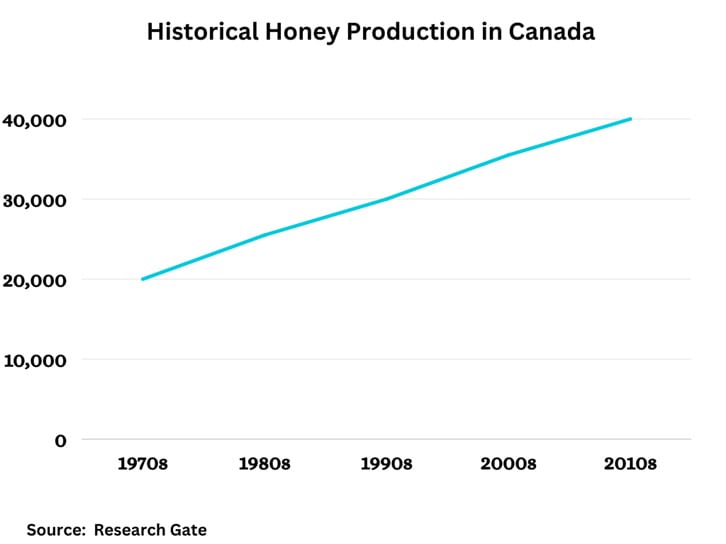Canadians used honey long before settlers came. Indigenous peoples collected wild honey. They used it as medicine for over 1000 years. European settlers brought honey bees in the 1600s. This changed beekeeping and honey production in Canada.
Indigenous Peoples Relied on Wild Honey
Canada’s First Nations peoples valued honey’s healing gifts. They gathered wild honey from beehives. This lets them use it as natural medicine. Honey was a rare treat before settlers came. Bees needed to find the right flowers and climate. This limited wild hives in Canada. So finding honey took great skill.
First Nations used smoke and fires to take honey from hives. They saw honey’s antibiotic properties. It treated wounds, burns, and infections. Elders passed down the knowledge. Honey held cultural and spiritual meaning.
Settlers Spread Modern Beekeeping
European settlers brought tools and bees. This made honey production expand greatly.
The first honey bees came to Nova Scotia from England in the 1620s. Swarms traveled west with settlers. By the 1800s, most settlers had beehives.
Settlers used hollow logs as early beehives. Later wood and straw hives let bees make more honey. New frames and extractors made harvesting honey easier. More food crops meant more flowers for bees. Settlers supplied cities with beeswax, mead, and honey. Canada started large-scale honey farming.
Canada’s Diverse Lands Give Unique Honey
Among the many signature honeys produced across Canada’s ecologically diverse landscapes, white honey stands out for its delicate flavor and light color. This premium variety comes primarily from clover, alfalfa, and other legume blossoms growing on the Canadian Prairies. The wide open grasslands and meadows of Manitoba, Saskatchewan, and Alberta provide bees with a bounty of these mildly sweet flowers, resulting in a distinctive honey perfect for many uses.
White honey takes on a pale golden hue rather than a dark robust tone. This light color results from the nectar bees gather from the subdued blossoms blanketing the Prairies. Legume flowers tend to be small and white or purple in color compared to the bold yellows and oranges of citrus blossoms or sunflowers. Their muted palette lends a more refined shade to the honey.
A Subtle Sweetness
The flavor of white honey is just as delicate as its appearance. Notes of vanilla, cinnamon, and clover create a clean sweetness without overpowering intensity. The aroma is floral and fruity compared to the woodsy scents of wildflower honey. Since legume nectar crystallizes slowly, this premium Canadian honey maintains a creamy, spreadable texture ideal for drizzling over foods.
This versatility makes white premium Canadian honey perfect for everything from sweetening teas to topping waffles. Its mildness lets other ingredients shine rather than masking flavors. The smooth consistency and neutral taste also make this white premium Canadian honey ideal for use in baked goods. It blends well with ingredients from grains to fruits. Everything from cakes to muffins benefit from the touch of sweetness and moisture this premium Canadian white honey imparts.
Regional Nuances
With its subtle qualities, white honey allows the diverse botanicals of Canada to flavor it uniquely based on region. White honey from Manitoba takes on hints of wild mint and pine from fields edged by boreal forests. Saskatchewan’s wildflowers add undertones of lavender and citrus. Alberta’s mix of canola and meadow blooms creates white honey with extra floral aromas.
No other country can produce white honey with the same variety. Canada’s vast prairie expanses containing clover, alfalfa, and legumes give bees access to millions of tiny blossoms. The diverse ecosystems surrounding the grasslands further distinguish each area’s honey. This premium white honey exemplifies how Canada’s landscapes create one-of-a-kind taste.
Ideal for Highlighting Terroir
From its pale golden color to its delicate flavor, white honey allows the diverse Canadian terroir to shine. Other honeys overwhelm the palate with assertive notes. But the refined profile of white honey highlights how ecological subtleties make Canadian honey unique. Whether paired with tea, baked into sweets, or savored on its own, this versatile white honey reflects the very best of Canada.
The Rise of Canadian Honey’s Popularity
Canada produces over 90 million pounds of honey each year. The industry keeps setting new records. In the 1900s, family-run apiaries bottled small batches under local brands. They sold at farmers markets and stores.
Canada exports premium honey to over 35 countries. Many new micro-producers focus on unique honeys. These artisanal brands create buzz at home and abroad.

Sustainability Drives Canadian Beekeeping
Canada produces over 90 million pounds of honey each year. The industry keeps setting new records as global demand for natural Canadian honey grows.
In the early 1900s, family-run apiaries bottled small batches under local brand names. They sold honey at farmers markets and in stores. National brands had not yet emerged.
After World War II, innovations like centrifugal extractors increased yields. Larger companies consolidated smaller producers as commercial beekeeping expanded. Major co-op brands like Bee Maid and Billy Bee led Canadian honey sales for decades.
Today over 7000 beekeepers operate in Canada. Improved equipment and transportation let companies efficiently harvest mass quantities of honey. National brands like Billy Bee, Bee Maid, and Maple Blossom Honey distribute millions of pounds worldwide.
Export markets for Canadian honey keep growing. Canada now exports premium honey to over 35 countries, including the US, Germany, UK, and Japan. Exports have surged over 25% in the past decade as global demand rises for natural, high-quality honey.
Many new micro-producers also focus on artisanal, single-origin honeys from local areas. These small batch honeys create buzz at farmers markets. Popular artisanal brands like Smoothedge Honey, Sunny North Honey, and Niagara region honeys highlight local terroir.
Support for Canadian honey as a superfood and natural product has boosted popularity. Consumers want quality ingredients and ethical production. This perfectly aligns with Canada’s sustainable beekeeping practices.
The prospects for growth in Canadian honey look sweet. Rising global populations and concerns over adulterated imported honey should keep sales of authentic, pure Canadian honey climbing.
Celebrating Canada’s Honey Legacy
Canadians hold numerous honey festivals each year. Over 15 festivals across Canada honor honey’s heritage. One highlight is the St-Ambroise Honey Festival in Quebec. It features honey tastings, chef demos, and beekeeping awards.
Festivals showcase new harvesting tools and methods. Beekeeping contests reward top producers. Events aim to educate and inspire honey fans.
Honey in Canadian Cooking Traditions
Honey’s influence on Canadian cuisine runs deep. It features in over 200 traditional preparations. Indigenous communities used it to sweeten pemmican and desserts. Early settlers baked it into bread loaves and brewed mead.
Today chefs highlight honey in recipes like honey-ginger glazed salmon, maple honey cornbread, and honey-lemon tarts. Its sweetness balances savory and tangy flavors.
From campfire brook trout to gourmet plates, honey’s place in Canadian food heritage is secure.
The Sweet Future of Canadian Honey
Canada’s beekeeping continues to evolve. New technologies make harvesting more efficient. Research keeps improving hive health.
The desire for premium artisanal honey grows. Canada’s pristine landscapes will keep providing the best raw ingredients. Sustainable methods ensure healthy bees pollinate future flowers.
Canada’s honey heritage spans cultures and centuries. Its roots run as deep as maple syrup. Honey will keep delighting taste buds and livening traditions for generations to come.

